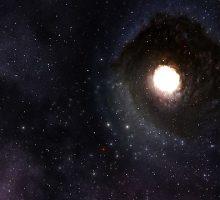Cosmic Rays and Dark Matter: Illuminating the Secrets of the Universe
Cosmic Rays and Dark Matter: Illuminating the Secrets of the Universe- “What are cosmic rays and where do they come from?”
- “The history of cosmic ray research: from Hess to present day”
- “The impact of cosmic rays on space exploration and human health”
- “The mysterious ultra-high energy cosmic rays: what are they and how are they detected?”
- “The connection between cosmic rays and solar activity”
- “Cosmic rays and their role in shaping the universe”
- “The cosmic ray spectrum: understanding the different types of cosmic rays”
- “The role of cosmic rays in the formation of life on Earth”
- “The challenges of studying cosmic rays: current research efforts and future prospects”
- “The relationship between cosmic rays and dark matter: exploring the mysteries of the universe”
- Conclusion
What are cosmic rays and where do they come from?
Cosmic rays, those high-energy particles that constantly bombard Earth from outer space, have fascinated scientists and space enthusiasts for decades. These particles originate from a variety of sources, including exploding stars, supernovae, black holes, and other astrophysical phenomena.
The mystery of cosmic rays lies in their ability to penetrate through Earth’s atmosphere, reaching the surface with incredible amounts of energy. Scientists have been studying cosmic rays for years, and yet, there is still much to be discovered about their origins and properties.
One thing that we do know is that cosmic rays are not really “rays” at all, but rather charged particles such as protons, electrons, and atomic nuclei. These particles are accelerated to extremely high energies by various astrophysical processes, such as shock waves created by supernovae explosions.
Cosmic rays come in different types and energies, ranging from low-energy cosmic rays that originate from our own Sun to ultra-high energy cosmic rays that have energies billions of times greater than the particles produced in man-made accelerators.
Studying cosmic rays is important for understanding the structure and evolution of our universe. They provide a unique window into astrophysical phenomena that are difficult to observe through other means. As our knowledge of cosmic rays continues to expand, we may be able to unlock even more secrets about the cosmos and our place in it.
The history of cosmic ray research: from Hess to present day
Cosmic rays were first discovered over a century ago by the Austrian physicist, Victor Hess. In 1912, he conducted a series of balloon flights to measure the ionizing radiation in the atmosphere. He discovered that the ionization levels increased at higher altitudes, which led him to conclude that the radiation was coming from outer space. This discovery laid the foundation for the study of cosmic rays, which has since become a vital area of research in astrophysics.
Over the years, scientists have made significant strides in understanding cosmic rays and their origins. In the 1920s and 30s, researchers used cloud chambers to study the properties of cosmic rays. They discovered that cosmic rays were composed of charged particles, such as protons and electrons, and that they could be deflected by magnetic fields.
In the 1940s and 50s, advances in technology allowed scientists to build particle accelerators that could produce cosmic ray-like particles. This allowed researchers to conduct experiments on Earth to study the properties of cosmic rays in a controlled environment.
The 1960s and 70s saw the emergence of space-based experiments that could directly measure cosmic rays outside of Earth’s atmosphere. These experiments provided new insights into the properties of cosmic rays and their sources. Scientists discovered that the energy spectrum of cosmic rays followed a power law distribution, which suggested that there were both galactic and extragalactic sources of cosmic rays.
In recent decades, advancements in technology and new observatories have allowed scientists to study cosmic rays in even greater detail. The IceCube Neutrino Observatory in Antarctica, for example, is designed to detect cosmic neutrinos, which can help identify the sources of ultra-high energy cosmic rays.
Today, cosmic ray research is a vibrant and exciting field, with researchers from around the world working to uncover the mysteries of these high-energy particles. From the early balloon flights of Victor Hess to the cutting-edge experiments of the present day, the history of cosmic ray research is a testament to the human drive to explore and understand the universe around us.
The impact of cosmic rays on space exploration and human health
Cosmic rays are not just fascinating astrophysical phenomena, they also have important implications for space exploration and human health. As space agencies plan missions to deep space and potentially even beyond our solar system, the effects of cosmic rays on spacecraft and astronauts must be carefully considered.
One of the major concerns is the impact of cosmic rays on human health. Cosmic rays can penetrate the human body, causing damage to cells and DNA. This damage can lead to an increased risk of cancer and other health problems. Astronauts on long-duration space missions are particularly vulnerable to the effects of cosmic rays, and scientists are working to develop better ways to protect them from exposure.
Another concern is the impact of cosmic rays on spacecraft. Cosmic rays can cause electronic glitches and other malfunctions in spacecraft systems, which can be dangerous for crewed missions. Shielding and other protective measures are necessary to prevent damage to spacecraft electronics.
Despite these challenges, space agencies are working to find ways to mitigate the effects of cosmic rays. Some spacecraft, such as the International Space Station, have shielding to protect astronauts from radiation exposure. Researchers are also developing new materials and technologies that can provide better protection from cosmic rays.
At the same time, scientists are studying the effects of cosmic rays on the human body in order to better understand the risks and develop effective countermeasures. For example, studies of astronauts on the International Space Station have helped researchers better understand the long-term effects of radiation exposure on the human body.
Overall, the impact of cosmic rays on space exploration and human health is an important area of research that will become increasingly important as we continue to explore the cosmos. By developing better ways to protect astronauts and spacecraft, we can ensure that we can continue to push the boundaries of human knowledge and explore the wonders of the universe.
The mysterious ultra-high energy cosmic rays: what are they and how are they detected
Cosmic rays are high-energy particles that constantly bombard the Earth from outer space, but some of these particles are so energetic that they are known as ultra-high energy cosmic rays (UHECRs). UHECRs are incredibly rare, with only a few particles detected on Earth per year, and their origins remain a mystery.
UHECRs are particles with energies above 10^18 electron volts (eV), which is about 10 million times more energetic than the particles produced in man-made particle accelerators. Because of their extreme energy, UHECRs are thought to originate from the most violent and energetic events in the universe, such as gamma-ray bursts or supermassive black hole accretion disks.
Detecting UHECRs is a major challenge, as they are incredibly rare and require large detectors to capture their signals. The most common method for detecting UHECRs is through ground-based observatories, such as the Pierre Auger Observatory in Argentina and the Telescope Array in Utah. These observatories use large arrays of detectors spread over several hundred square kilometers to measure the arrival times and energies of UHECRs.
Another method for detecting UHECRs is through space-based experiments, such as the Extreme Universe Space Observatory (EUSO). EUSO is a proposed space-based observatory that would use the Earth’s atmosphere as a giant detector to measure the light produced by UHECRs as they pass through the atmosphere.
Despite decades of research, the origins of UHECRs remain a mystery. Scientists continue to search for clues to the origins of these particles, which could provide valuable insights into the most extreme and energetic phenomena in the universe.
The connection between cosmic rays and solar activity
The Sun is not only a source of heat and light for life on Earth, it also produces a constant stream of charged particles known as the solar wind. This solar wind interacts with cosmic rays, which are high-energy particles from outside our solar system, and can have significant effects on Earth’s climate and space weather.
The Sun’s activity follows an 11-year cycle, during which the number of sunspots and other solar activity peaks and then drops again. During periods of high solar activity, the solar wind is stronger, which can deflect more cosmic rays away from Earth. Conversely, during periods of low solar activity, the solar wind weakens and more cosmic rays reach Earth’s atmosphere.
This connection between solar activity and cosmic rays has important implications for Earth’s climate. Cosmic rays can ionize the atmosphere, leading to the formation of aerosols and clouds. Some studies suggest that during periods of low solar activity, when more cosmic rays reach Earth’s atmosphere, there may be more clouds, which can reflect sunlight and lead to a cooling effect on Earth’s climate.
Solar activity also has significant effects on space weather. The strong magnetic fields associated with sunspots can create powerful solar flares and coronal mass ejections, which can release vast amounts of charged particles into space. These particles can have serious effects on satellites, power grids, and other infrastructure on Earth.
Understanding the connection between cosmic rays and solar activity is an important area of research. Scientists use ground-based and space-based observatories to study the Sun and its activity, and to track the effects of solar activity on Earth’s climate and space weather. By better understanding these phenomena, we can develop strategies to mitigate their effects and protect our technology and infrastructure from the damaging effects of space weather.
Cosmic rays and their role in shaping the universe
Cosmic rays are high-energy particles that are constantly bombarding our planet from outer space. They come in a variety of different types, including protons, electrons, and even atomic nuclei. While cosmic rays are often studied for their potential impact on Earth’s climate and space weather, they also play an important role in shaping the universe as a whole.
One of the most important roles of cosmic rays is in the formation and evolution of galaxies. Cosmic rays are thought to be produced by some of the most extreme phenomena in the universe, such as supernovae, active galactic nuclei, and gamma-ray bursts. These energetic events can create and accelerate cosmic rays to extremely high energies, allowing them to penetrate deep into the interstellar medium and interact with other particles.
One key way that cosmic rays shape the universe is through the ionization and heating of interstellar gas. As cosmic rays collide with atoms and molecules in the interstellar medium, they can strip away electrons, creating a highly ionized gas that is more prone to further reactions and chemical processes. This ionization can also lead to heating of the gas, which can influence the dynamics and evolution of the surrounding gas clouds.
Cosmic rays can also have a significant impact on the magnetic fields of galaxies. As cosmic rays move through magnetic fields, they can create waves and fluctuations that alter the structure and strength of the magnetic field. This in turn can affect the motion of gas and dust in the galaxy, as well as the behavior of cosmic rays themselves.
Finally, cosmic rays are also thought to play a role in the creation and acceleration of high-energy particles known as “ultra-high energy cosmic rays” (UHECRs). These particles have energies that are orders of magnitude higher than typical cosmic rays and are thought to originate from the most extreme and energetic events in the universe, such as gamma-ray bursts or supermassive black hole accretion disks.
The cosmic ray spectrum: understanding the different types of cosmic rays
Cosmic rays are high-energy particles that originate from outer space and travel at nearly the speed of light. They come in a wide range of energies and types, ranging from low-energy particles such as electrons to ultra-high energy cosmic rays (UHECRs) with energies up to 100 million times greater than those produced by the Large Hadron Collider.
The cosmic ray spectrum is a graph that shows the number of cosmic rays detected versus their energy. It is an essential tool for understanding the different types of cosmic rays and the sources that produce them.
At the low end of the cosmic ray spectrum are particles such as electrons and positrons, which make up what is known as the “low-energy component” of cosmic rays. These particles are thought to be produced by the Sun and other nearby stars and are primarily affected by the magnetic fields in our solar system.
The “high-energy component” of the cosmic ray spectrum includes particles such as protons and helium nuclei, which have energies that are several orders of magnitude higher than those of the low-energy component. These particles are thought to be produced by supernovae, black holes, and other energetic events in our galaxy and beyond.
At the highest end of the cosmic ray spectrum are UHECRs, which have energies that are so high that their sources and acceleration mechanisms are not yet fully understood. Some theories suggest that they may originate from the most extreme phenomena in the universe, such as active galactic nuclei or gamma-ray bursts.
Understanding the cosmic ray spectrum is critical for determining the sources and mechanisms that produce these high-energy particles. Scientists use a variety of methods to detect cosmic rays, including ground-based observatories and space-based instruments such as the Cosmic Ray Energetics and Mass (CREAM) experiment and the Alpha Magnetic Spectrometer (AMS) on the International Space Station.
The role of cosmic rays in the formation of life on Earth
The origins of life on Earth have long been shrouded in mystery. However, recent research has suggested that cosmic rays may have played a significant role in the formation of life on our planet.
Cosmic rays are high-energy particles that originate from outer space and are constantly bombarding the Earth’s atmosphere. These particles can interact with molecules in the atmosphere, leading to the creation of new molecules and chemical reactions. Some of these reactions could have led to the formation of the building blocks of life, such as amino acids and nucleotides.
In addition to their potential role in the formation of organic molecules, cosmic rays may also have played a role in the evolution of life on Earth. Research has shown that cosmic rays can cause mutations in DNA, leading to genetic diversity and potentially driving evolution.
Furthermore, some researchers have proposed that cosmic rays may have played a role in the creation of the first living organisms. The early Earth was bombarded by a much higher rate of cosmic rays than today, due to a weaker magnetic field and a lack of protective ozone layer. This high rate of cosmic rays may have triggered chemical reactions that eventually led to the formation of simple living organisms.
While the role of cosmic rays in the formation of life on Earth is still a topic of active research and debate, there is mounting evidence to suggest that they may have played a significant role. Understanding the ways in which cosmic rays can influence the formation and evolution of life is critical for our understanding of the origins of life not only on Earth but potentially on other planets throughout the universe.
The challenges of studying cosmic rays: current research efforts and future prospects
Studying cosmic rays is no easy task. These high-energy particles are constantly bombarding the Earth, and detecting and analyzing them presents significant challenges to researchers. However, despite these challenges, there has been significant progress in the field of cosmic ray research, and ongoing efforts hold promise for future discoveries.
One of the major challenges in studying cosmic rays is that they are constantly interacting with the Earth’s atmosphere, magnetic field, and other particles, which can alter their paths and energies. To overcome this challenge, researchers have developed a variety of detectors and instruments to capture and analyze cosmic rays from space, such as the Cherenkov Telescope Array (CTA) and the Pierre Auger Observatory.
Another challenge in cosmic ray research is the need to distinguish between different types of cosmic rays, each with unique properties and origins. Researchers use a variety of methods, such as particle detectors and mass spectrometry, to identify and analyze the composition of cosmic rays.
In recent years, there have been significant advances in our understanding of cosmic rays. For example, researchers have discovered a new class of cosmic rays known as ultra-high energy cosmic rays (UHECRs), which have energies up to 100 million times greater than those produced by the Large Hadron Collider. The discovery of these particles has led to new insights into the most extreme phenomena in the universe, such as active galactic nuclei and gamma-ray bursts.
Looking forward, there are several promising areas of research in cosmic ray physics. For example, researchers are studying the potential for using cosmic rays to image the interior of volcanoes and other geologic structures. Additionally, there is ongoing research into the potential for cosmic rays to be used for medical imaging and cancer treatment.
However, there are still many unanswered questions in the field of cosmic ray research. For example, the sources and acceleration mechanisms of UHECRs are still not fully understood, and the potential impact of cosmic rays on climate and atmospheric chemistry is an area of active research.
The relationship between cosmic rays and dark matter: exploring the mysteries of the universe
The universe is full of mysteries, and one of the biggest mysteries is the nature of dark matter. Although we cannot directly observe dark matter, we know that it makes up a significant portion of the universe’s mass. In recent years, there has been growing interest in the potential relationship between cosmic rays and dark matter, and how studying cosmic rays could help us unravel the mysteries of the universe.
One of the key ways that cosmic rays could help us understand dark matter is through the study of high-energy gamma rays. Dark matter is thought to be made up of particles that do not interact with ordinary matter, but can interact with each other and emit gamma rays when they collide. By studying the spectrum and distribution of these gamma rays, researchers hope to gain insights into the properties of dark matter particles and their interactions with other matter.
In addition to gamma rays, cosmic rays could also provide indirect evidence for the existence of dark matter. Some theories suggest that dark matter particles could be responsible for the production of cosmic rays, and that the characteristics of these cosmic rays could reveal information about dark matter properties. For example, some models suggest that cosmic rays produced by dark matter could have unique features such as an excess of positrons or antiprotons, which could be detected and studied by researchers.
There are also theoretical connections between cosmic rays and dark matter in the formation and evolution of galaxies. It is believed that the distribution of dark matter plays a crucial role in shaping the structure of galaxies, and cosmic rays could provide clues about this process. By studying the distribution and behavior of cosmic rays in different regions of the universe, researchers hope to gain insights into the nature of dark matter and its role in the universe.
Despite the potential for cosmic rays to shed light on the mysteries of dark matter, there are still significant challenges to be overcome. Detecting and analyzing cosmic rays is a complex and difficult task, and distinguishing between different types of cosmic rays and their sources can be challenging. Additionally, the nature of dark matter itself is still not well understood, and more research is needed to fully understand its properties and interactions with other matter.
Conclusion
In conclusion, cosmic rays are high-energy particles that originate from various sources in the universe, ranging from our sun to distant supernovae. Over the years, researchers have made significant progress in understanding the nature of cosmic rays, their impact on space exploration and human health, and their role in shaping the universe.
The study of cosmic rays has a long and fascinating history, from the pioneering work of Victor Hess in the early 20th century to the advanced research methods and technologies of present-day scientists. Despite the many challenges of studying cosmic rays, researchers remain committed to advancing our understanding of these high-energy particles and their role in the universe.
From their potential role in the formation of life on Earth to their connections with dark matter, cosmic rays continue to inspire new questions and avenues of research. As we continue to explore the mysteries of the universe, cosmic rays will undoubtedly play a critical role in our ongoing quest for knowledge and understanding.
https://www.youtube.com/channel/UChPmS9xqsw5FOgOHXTK69QQ
https://scitechventure.com/dark-energy/(opens in a new tab)
- What is Ozone Hole & How is it formed
 Earth layer Our Earth is surrounded by layers such as the troposphere, stratosphere, mesosphere, thermosphere, and exosphere. The troposphere is the lowest layer in our Earth’s atmosphere, meaning it is closest to us, and it has an impact on our weather and climate. Above the troposphere is the stratosphere, which protects us from harmful ultraviolet (UV) radiation. The air movement in this layer is relatively slow. Beyond the stratosphere, we find the mesosphere, where temperatures are low, and meteorites and shooting stars burn up. The mesosphere has low pressure and serves as a protective barrier between space and Earth. Above […]
Earth layer Our Earth is surrounded by layers such as the troposphere, stratosphere, mesosphere, thermosphere, and exosphere. The troposphere is the lowest layer in our Earth’s atmosphere, meaning it is closest to us, and it has an impact on our weather and climate. Above the troposphere is the stratosphere, which protects us from harmful ultraviolet (UV) radiation. The air movement in this layer is relatively slow. Beyond the stratosphere, we find the mesosphere, where temperatures are low, and meteorites and shooting stars burn up. The mesosphere has low pressure and serves as a protective barrier between space and Earth. Above […] - Aditya L1 Mission :- ISRO is sending satellite on Sun
 You must be aware that recently we Indians have achieved what until now few countries attempted but couldn’t succeed in. That is, no country had successfully landed on the south pole of the moon until now. On August 23, 2023, India’s Chandrayaan 3, at 6:02 AM, achieved a successful landing on the southern pole of the moon. This accomplishment has propelled India’s name further in the global arena of science and technology. This achievement is not only going to benefit India financially but also signifies a significant step forward. Moreover, following the successful lunar landing of Chandrayaan 3, India has […]
You must be aware that recently we Indians have achieved what until now few countries attempted but couldn’t succeed in. That is, no country had successfully landed on the south pole of the moon until now. On August 23, 2023, India’s Chandrayaan 3, at 6:02 AM, achieved a successful landing on the southern pole of the moon. This accomplishment has propelled India’s name further in the global arena of science and technology. This achievement is not only going to benefit India financially but also signifies a significant step forward. Moreover, following the successful lunar landing of Chandrayaan 3, India has […] - Eye Flu | How Dangerous is Conjunctivitis | symptoms | cause | treatment
 These days, there is a rapid spread of eye flu in India. In this, people’s eyes become red along with swelling and irritation in the eyes. In today’s article, we will discuss in detail about eye flu – why it is spreading so rapidly, how dangerous it is, which virus is causing this, what its symptoms are, how to protect oneself from eye flu, and what to do if one gets eye flu. What is Eye Flu Eye flu, also known as conjunctivitis, is a common eye infection. It typically occurs due to viral or bacterial infections and can easily […]
These days, there is a rapid spread of eye flu in India. In this, people’s eyes become red along with swelling and irritation in the eyes. In today’s article, we will discuss in detail about eye flu – why it is spreading so rapidly, how dangerous it is, which virus is causing this, what its symptoms are, how to protect oneself from eye flu, and what to do if one gets eye flu. What is Eye Flu Eye flu, also known as conjunctivitis, is a common eye infection. It typically occurs due to viral or bacterial infections and can easily […] - The Heart of Mars: Seismic Waves Reveal the Red Planet’s Inner Secrets
 Uncovering the Mysteries of Mars Seismic waves are vibrations that can travel through the inside of a planet, just like they do on Earth. By detecting and analyzing these waves on Mars, scientists are learning more about the planet’s internal structure and how it formed. This is important because it helps us better understand how planets form and evolve, and whether or not they could support life. The use of seismic waves to study Mars is an exciting development in planetary science, as it has the potential to revolutionize our understanding of not just Mars, but other planets as well. […]
Uncovering the Mysteries of Mars Seismic waves are vibrations that can travel through the inside of a planet, just like they do on Earth. By detecting and analyzing these waves on Mars, scientists are learning more about the planet’s internal structure and how it formed. This is important because it helps us better understand how planets form and evolve, and whether or not they could support life. The use of seismic waves to study Mars is an exciting development in planetary science, as it has the potential to revolutionize our understanding of not just Mars, but other planets as well. […] - Overview | Lunar Phases of the Moon | ScitechVenture
 Understanding the Phases of the Moon The moon has fascinated humanity since the beginning of time. It has been the subject of countless myths, legends, and scientific studies. However, for many people, the phases of the moon can be confusing. In this beginner’s guide, we’ll take a closer look at the phases of the moon, what causes them, and how to observe them. What are the Phases of the Moon? The moon goes through different phases as it orbits around the Earth. These phases are determined by the angle between the sun, Earth, and the moon. As the moon orbits […]
Understanding the Phases of the Moon The moon has fascinated humanity since the beginning of time. It has been the subject of countless myths, legends, and scientific studies. However, for many people, the phases of the moon can be confusing. In this beginner’s guide, we’ll take a closer look at the phases of the moon, what causes them, and how to observe them. What are the Phases of the Moon? The moon goes through different phases as it orbits around the Earth. These phases are determined by the angle between the sun, Earth, and the moon. As the moon orbits […]








